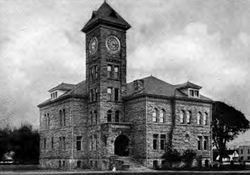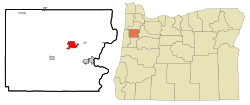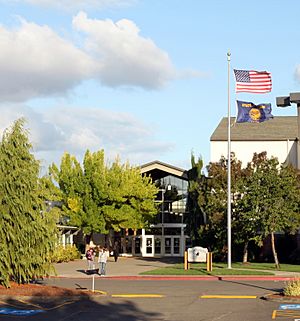Dallas, Oregon facts for kids
Quick facts for kids
Dallas, Oregon
|
|
|---|---|

Polk County Courthouse
|
|

Location in Polk County, Oregon
|
|
| Country | United States |
| State | Oregon |
| County | Polk |
| Incorporated | 1874 |
| Area | |
| • Total | 4.91 sq mi (12.71 km2) |
| • Land | 4.91 sq mi (12.71 km2) |
| • Water | 0.00 sq mi (0.00 km2) |
| Elevation | 322 ft (98 m) |
| Population
(2020)
|
|
| • Total | 16,854 |
| • Density | 3,435.39/sq mi (1,326.42/km2) |
| Time zone | UTC-8 (Pacific) |
| • Summer (DST) | UTC-7 (Pacific) |
| ZIP code |
97338
|
| Area code(s) | 503 and 971 |
| FIPS code | 41-17700 |
| GNIS feature ID | 2410287 |
Dallas is a city in Oregon, United States. It is the main city of Polk County. In 2020, about 16,854 people lived there.
The city is located along Rickreall Creek. It is about 15 miles (24 km) west of Salem. Dallas is about 325 feet (99 m) above sea level. It is part of the larger Salem area.
Contents
History of Dallas
How Dallas Got Its Name
Pioneers started a settlement in the 1840s. It was on the north side of Rickreall Creek. This settlement was first called "Cynthian" or "Cynthiana."
One story says Mrs. Thos. Lovelady named it after her hometown. Her hometown was Cynthiana, Kentucky. Another idea was that Cynthia Ann, wife of pioneer Jesse Applegate, named it. But she lived in a different area.
The Dallas post office opened in 1852. In 1856, the town moved more than a mile south. This was because it did not have enough water.
Becoming the County Seat
Cynthiana wanted to be the county seat. This meant it would be the main city for the county. It competed with Independence.
The people of Cynthiana raised $17,000. This money helped build a branch of the narrow gauge railroad to their town. Getting the railroad helped them become the county seat. This also brought more business to the town. The train line was built between 1878 and 1880.
Town leaders thought "Cynthiana" did not sound strong enough. So, they changed the name to "Dallas." They chose this name because George Mifflin Dallas was the Vice-President. He served under James K. Polk, who the county was named after.
Dallas officially became a town in 1874. It became a city in 1901.
Early Businesses and Railroads
In 1901, Louis Gerlinger, Sr. started a railroad company. It was called the Salem, Falls City and Western Railway. He planned to build a railroad from Salem to the Siletz River. This was a distance of about 65 miles (105 km).
In 1902, Louis's son, George T. Gerlinger, helped build more railroad lines. On May 29, 1903, the first train ran from Dallas to Falls City. By late June, passenger trains ran daily. The 9-mile (14 km) trip took 40 minutes and cost 35 cents.
Willamette Industries started in Dallas in 1906. It was first called Willamette Valley Lumber Company. Louis Gerlinger, Sr. was the president. George T. Gerlinger was the manager.
Later, in 1967, Willamette Valley Lumber joined with other companies. They became Willamette Industries. In the early 2000s, larger companies bought these local businesses. This changed the local economy. In 2002, Weyerhaeuser Company bought Willamette Industries. Weyerhaeuser closed its Dallas operation in 2009. Another company, Towmotor, took over Gerlinger Carrier Company.
Geography and Climate
Where is Dallas Located?
The city of Dallas covers about 4.81 square miles (12.46 km2) of land. There is no water area within the city limits.
Dallas Weather
Dallas has a Mediterranean climate. This means it has warm, dry summers. The mornings are cool. Winters are cold and rainy.
Sometimes, very cold air from Canada can reach the area. This can cause very low temperatures. For example, in January 1950, it got as cold as −11 °F (−23.9 °C). Snowfall is rare, with about 4.9 inches (12 cm) per year.
Winters have a lot of rain. From November to February, it rains over 6.50 inches (170 mm) each month. It rains about 17 days a month during this time. The wettest month ever was December 1996, with 21.93 inches (557.0 mm) of rain.
Spring arrives slowly. It has nice afternoon temperatures. Rain showers are common until June. Summer (July and August) is very warm and dry. It can go for many days without rain. The hottest month was August 1967. The average high temperature was 92.1 °F (33.4 °C). The highest temperature ever recorded was 106 °F (41.1 °C). This happened on July 19, 1956, and August 8, 1981.
On average, the temperature goes above 90 °F (32.2 °C) about 18 afternoons a year. It rarely reaches 100 °F (37.8 °C). Temperatures drop below freezing about 62 mornings a year.
| Climate data for Dallas, Oregon | |||||||||||||
|---|---|---|---|---|---|---|---|---|---|---|---|---|---|
| Month | Jan | Feb | Mar | Apr | May | Jun | Jul | Aug | Sep | Oct | Nov | Dec | Year |
| Record high °F (°C) | 65 (18) |
71 (22) |
90 (32) |
88 (31) |
98 (37) |
110 (43) |
106 (41) |
106 (41) |
104 (40) |
91 (33) |
76 (24) |
66 (19) |
110 (43) |
| Mean daily maximum °F (°C) | 45.3 (7.4) |
49.7 (9.8) |
55.2 (12.9) |
60.4 (15.8) |
66.9 (19.4) |
73.0 (22.8) |
80.9 (27.2) |
81.5 (27.5) |
76.7 (24.8) |
64.7 (18.2) |
50.7 (10.4) |
44.2 (6.8) |
62.4 (16.9) |
| Mean daily minimum °F (°C) | 33.1 (0.6) |
34.8 (1.6) |
36.9 (2.7) |
39.4 (4.1) |
43.7 (6.5) |
47.8 (8.8) |
50.4 (10.2) |
49.8 (9.9) |
47.0 (8.3) |
41.2 (5.1) |
37.2 (2.9) |
33.2 (0.7) |
41.2 (5.1) |
| Record low °F (°C) | −11 (−24) |
−2 (−19) |
10 (−12) |
24 (−4) |
27 (−3) |
31 (−1) |
35 (2) |
34 (1) |
30 (−1) |
22 (−6) |
9 (−13) |
−2 (−19) |
−11 (−24) |
| Average rainfall inches (mm) | 7.82 (199) |
6.66 (169) |
5.33 (135) |
3.24 (82) |
2.21 (56) |
1.41 (36) |
0.50 (13) |
0.67 (17) |
1.44 (37) |
3.28 (83) |
7.79 (198) |
8.78 (223) |
49.13 (1,248) |
| Average rainy days (≥ 0.01 inch) | 17.7 | 15.5 | 16.4 | 12.8 | 10.3 | 7.2 | 3.3 | 3.5 | 6.5 | 10.4 | 17.5 | 17.6 | 138.7 |
People of Dallas
| Historical population | |||
|---|---|---|---|
| Census | Pop. | %± | |
| 1880 | 670 | — | |
| 1890 | 848 | 26.6% | |
| 1900 | 1,271 | 49.9% | |
| 1910 | 2,124 | 67.1% | |
| 1920 | 2,701 | 27.2% | |
| 1930 | 2,975 | 10.1% | |
| 1940 | 3,579 | 20.3% | |
| 1950 | 4,793 | 33.9% | |
| 1960 | 5,072 | 5.8% | |
| 1970 | 6,361 | 25.4% | |
| 1980 | 8,530 | 34.1% | |
| 1990 | 9,422 | 10.5% | |
| 2000 | 12,459 | 32.2% | |
| 2010 | 14,583 | 17.0% | |
| 2020 | 16,854 | 15.6% | |
| Sources: | |||
In 2010, there were 14,583 people living in Dallas. There were 5,747 households. About 3,952 families lived in the city. The city had about 3,032 people per square mile.
Most people in Dallas were White (92.6%). Other groups included Native American (2.0%) and Asian (0.8%). About 5.9% of the people were Hispanic or Latino.
About 32.2% of households had children under 18. Many households (51.8%) were married couples. About 13.7% of households had someone living alone who was 65 or older. The average household had 2.49 people.
The average age in Dallas was 39.8 years. About 25% of residents were under 18. About 18.8% were 65 or older. There were slightly more females (52.1%) than males (47.9%).
City Services
Media and News
The Polk County Itemizer-Observer is a weekly newspaper. It has been published in Dallas since 1875. KWIP (880 AM) is the only radio station in the city.
Important Buildings
Dallas has one hospital, West Valley Hospital. Oregon Route 223 is the main state highway that goes through the city.
Famous People from Dallas
Many interesting people have come from Dallas, Oregon. Here are a few:
- Jeri Ellsworth: A self-taught computer chip designer.
- Darcy Fast: A baseball pitcher who played for the Chicago Cubs.
- Carl Gerlinger: He started the Gerlinger Carrier Company.
- George T. Gerlinger: He was one of the founders of Willamette Industries.
- Irene Hazard Gerlinger: She was the first woman to be a regent (a leader) at the University of Oregon.
- Louis Gerlinger Sr.: He started the Salem, Falls City and Western Railway.
- Mark Hatfield: He was a former Governor of Oregon. He also served as a United States senator for many years.
- Johnny Kitzmiller: A football player who is in the College Football Hall of Fame.
- Jordan Poyer: A professional football player for the Buffalo Bills.
- Johnnie Ray: A famous singer from the 1950s.
See also
 In Spanish: Dallas (Oregón) para niños
In Spanish: Dallas (Oregón) para niños


